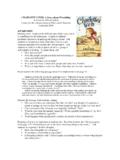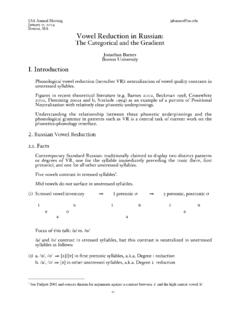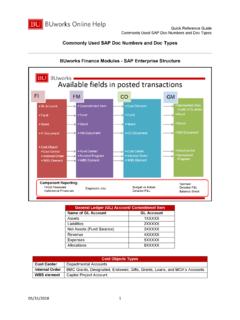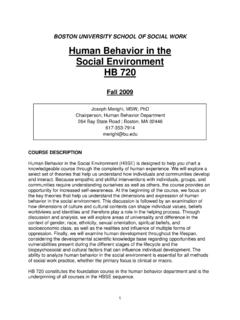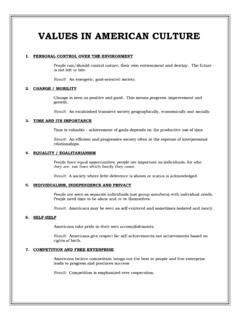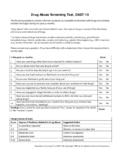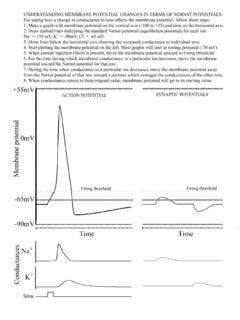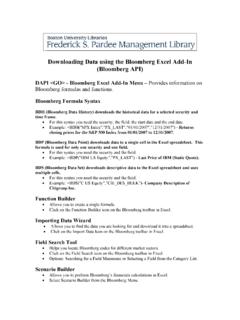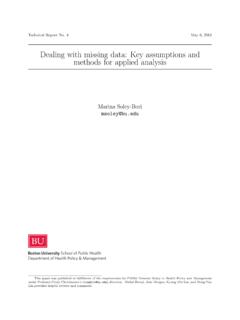Transcription of Marina Tech Report - Boston University
1 Technical Report No. 4 May 6, 2013 Dealing with missing data: Key assumptions andmethods for applied analysisMarina paper was published in fulfillment of the requirements for PM931 Directed Study in Health Policy and Managementunder Professor Cindy Christiansen s direction. Michal Horn y, Jake Morgan, Kyung Min Lee, and Meng-YunLin provided helpful reviews and 1 Contents Executive Summary .. 2 Acronyms .. 3 1. Introduction .. 4 2. Missing data mechanisms .. 5 3. Patterns of 6 4. Methods for handling missing data .. 6 Conventional methods .. 6 Listwise deletion (or complete case analysis).
2 6 Imputation methods: .. 6 Advanced Methods .. 7 Multiple Imputation .. 7 Maximum Likelihood .. 8 Other advanced methods .. 9 Bayesian simulation methods .. 9 Hot deck imputation 10 5. Dealing with missing data using SAS .. 10 Multiple Imputation (MI) .. 11 Maximum Likelihood (ML) .. 13 6. Dealing with missing data using STATA .. 15 Multiple imputation .. 15 Other imputation methods available in STATA .. 15 7. Other software .. 16 8. Sources and useful resources .. 17 Page 2 Executive Summary This tech Report presents the basic concepts and methods used to deal with missing data.
3 After explaining the missing data mechanisms and the patterns of missingness, the main conventional methodologies are reviewed, including Listwise deletion, Imputation methods, Multiple Imputation, Maximum Likelihood and Bayesian methods. Advantages and limitations are specified so that the reader is able to identify the main trade-offs when using each method. The Report also summarizes how to carry out Multiple Imputation and Maximum Likelihood using SAS and STATA. Keywords: missing data, missing at random, missing completely at random, listwise deletion, imputation, multiple imputation, maximum likelihood.
4 Page 3 Acronyms MCA -Missing Completely at Random MAR -Missing at Random NMAR -Not Missing at Random MI -Multiple Imputation ML -Maximum Likelihood MCMC- Markov Chain Monte Carlo FCS-Fully conditional specification EM-Expectation Maximization OCDE-Organization for Economic Cooperation and Development Page 4 1. Introduction Missing data is a problem because nearly all standard statistical methods presume complete information for all the variables included in the analysis. A relatively few absent observations on some variables can dramatically shrink the sample size.
5 As a result, the precision of confidence intervals is harmed, statistical power weakens and the parameter estimates may be biased. Appropriately dealing with missing can be challenging as it requires a careful examination of the data to identify the type and pattern of missingness, and also a clear understanding of how the different imputation methods work. Sooner or later all researchers carrying out empirical research will have to decide how to treat missing data. In a survey, respondents may be unwilling to reveal some private information, a question may be inapplicable or the study participant simply may have forgotten to answer it.
6 Accordingly, the purpose of this Report is to clearly present the essential concepts and methods necessary to successfully deal with missing data. The rest of the Report is organized as follows: Section 2 and 3 explain the different missing data mechanisms and the patterns of missingness. Section 4 presents the main methods for dealing with missing data. I differentiate between conventional methods , which include Listwise Deletion and Imputation Methods, and advanced methods , which cover Multiple Imputation, Maximum Likelihood, Bayesian simulation methods and Hot-Deck imputation.
7 Finally, section 5 explains how to carry out Multiple Imputation and Maximum Likelihood using SAS and STATA. The Report ends with a summary of other software available for missing data and a list of the useful references that guided this Report . Across the Report , bear in mind that I will be presenting Second-Best solutions to the missing data problem as none of the methods lead to a data set as rich as the truly complete one. The only really good solution to the missing data problem is not to have any. So in the design and execution of research projects, it is essential to put great effort into minimizing the occurrence of missing data.
8 Statistical adjustments can never make up for sloppy research (Paul D. Allison, 2001) Page 5 2. Missing data mechanisms There are different assumptions about missing data mechanisms: a) Missing completely at random (MCAR): Suppose variable Y has some missing values. We will say that these values are MCAR if the probability of missing data on Y is unrelated to the value of Y itself or to the values of any other variable in the data set. However, it does allow for the possibility that missingness on Y is related to the missingness on some other variable X.
9 (Briggs et al., 2003) (Allison, 2001) *Example: We want to assess which are the main determinants of income (such as age). The MCAR assumption would be violated if people who did not Report their income were, on average, younger than people who reported it. This can be tested by dividing the sample into those who did and did not Report their income, and then testing a difference in mean age. If we fail to reject the null hypothesis, then we can conclude that the MCAR is mostly fulfilled (there could still be some relationship between missingness of Y and the values of Y).
10 B) Missing at random (MAR)-a weaker assumption than MCAR-: The probability of missing data on Y is unrelated to the value of Y after controlling for other variables in the analysis (say X). Formally: P(Y missing|Y,X) = P(Y missing|X) (Allison, 2001). *Example: The MAR assumption would be satisfied if the probability of missing data on income depended on a person s age, but within age group the probability of missing income was unrelated to income. However, this cannot be tested because we do not know the values of the missing data, thus, we cannot compare the values of those with and without missing data to see if they systematically differ on that variable.
